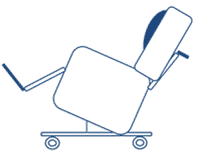Before you buy a Care Chair, consider the points below:
- If a person cannot support themselves when sitting in a chair, cannot change position on their own, and needs help to get in and out of a chair, then a posture support care chair is essential for providing a comfortable position to maintain skin health, joint range, respiration, digestion, and to encourage social interaction.

- Most posture support chairs are designed for people who use a mobile hoist or ceiling track for transfers.
- A ‘posture support care chair’ should be adjustable so that the seat depth, seat width, and seat height can be fitted to the person.
- The chair shape can be adjusted with special brackets and cushions to support a healthy sitting position.
- The chair should also have integral pressure relief in the seat, backrest, armrest, and leg rest and must have a footplate.
- The person’s feet must be properly supported by a footplate to distribute pressure evenly through the body, to help them position themselves if they can, and to help them feel safe and secure in the chair.
- Posture support chairs have a ’tilt in space’ adjustment to move the whole seat back into a gentle tilt, to support the person in the chair. Some will have additional adjustments to open the angle of the back rest, leg rest, and foot rest so people with different needs can sit comfortably.
- The back and leg rest angle adjustments on the chair can be operated with a lever or can be battery-powered with a handset. This allows the person or their carer to change the chair position for comfort and pressure relief.
- The posture support care chair has sturdy wheels with brakes so that the person can be moved safely in the chair from room to room if the doors and hallways are wide enough, which can reduce the need for hoisting.
- Consider what activities the person will be doing whilst in the chair and if they need access to a table.
- Assessment by a seating specialist is recommended when choosing a chair and to adjust the chair to fit that person.
- A record of the chair shape and the adjustments needed for that person, with pictures, is useful to help carers to keep the chair set up correctly.
- Regular reviews of skin health and body shape are important to check that the chair continues to support the person safely, with adjustments made as needed.
- To maintain a healthy body shape and reduce the risk of pressure ulcers it is important that the person has the opportunity to change position during the day and move from the chair to a bed, or another supporting surface.
- It is also important to consider support required in bed to maintain a healthy body shape.
Expect to pay from £2,500, (powered versions will cost more)